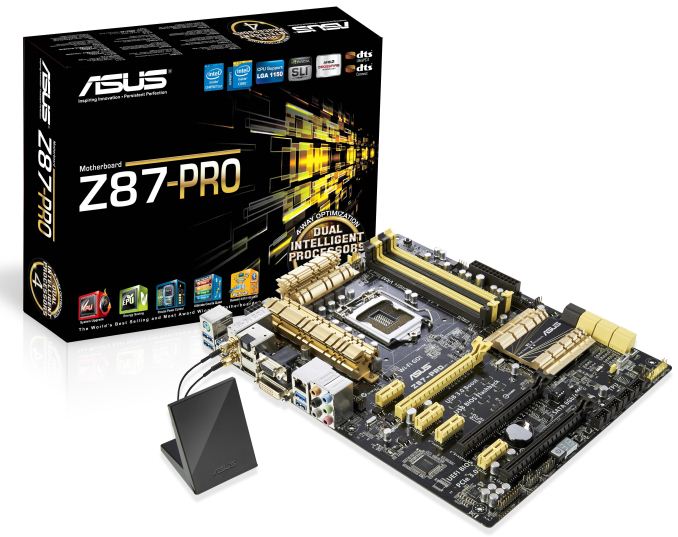Intel Z87 Motherboard Review with Haswell: Gigabyte, MSI, ASRock and ASUS
by Ian Cutress on June 27, 2013 8:00 AM EST- Posted in
- Motherboards
- Intel
- MSI
- Gigabyte
- ASRock
- Asus
- Haswell
- Z87
- Shark Bay
- Lynx Point
ASUS Z87-Pro Conclusion
The ASUS Z87-Pro sits between a rock and a hard place. ASUS is one of few motherboard companies that sit on the crest of innovation, coming up with new ideas that ultimately will filter through product ranges in each successive generation. Obviously the ones coming up with the ideas face the brunt of the cost, but unlike the medicine industry where markups are common if there is a sole solution to your problem, the motherboard market is cut-throat enough that the resellers, system integrators and end users dictate the pace of play with their wallet.
With all this being said it should be pointed out that the $200 price point is littered with competition, as we have already seen throughout this review. A motherboard manufacturer had to decide on layout, features, BOM costs and connectivity months ago – should they make a board designed to be at a higher price point and bring the cost down, or pull a motherboard up with a knockout blow on the credibility of the range. The ASUS comes into the market with a new style, new features, upgraded software and an incredibly nice to use BIOS. But at the same price point, other motherboards with more ports, more NICs, and 802.11ac exist. This is the hard point.
As far as testing the Z87 Pro, where have a large number of good points to discuss. The motherboard is efficient, boots fast, and has one of the better ALC1150 implementations despite not going the full way through to SupremeFX on the ROG side. Overclocking was also positive, and the ASMedia USB 3.0 ports reported similar speeds to the Intel points due to the lack of need for an ASMedia USB driver – the standard Intel one takes care of it.
The decision of ASUS to drop MultiCore Turbo from the main BIOS track is going to be a little strange, given that ASUS were the main protagonists in this field for the past two generations. MultiCore Turbo, when enabled, offers up to an additional 7% performance over a non-MCT enabled motherboard at stock settings and at full loading. The reasons given are simple: under stock conditions (i7-4770K in a case with the stock Intel cooler), a small (sub 5%) percentage of CPUs are forced to throttle due to heat generated. This is a combination of the Haswell architecture, the new stock Intel cooler, and features such as Adaptive Mode which struggle under artificial load. It kind of makes sense from a manufacturing point of view, but users who want MCT can follow the 3xxx BIOS track which has MCT enabled by default, or users can enable the option in the BIOS on the 1xxx track.
Another design choice made by ASUS is relating to the final PCIe slot. The board is wired up for PCIe 3.0 x8/x8 from the CPU and an additional PCIe 2.0 x4 from the chipset. ASUS have configured the chipset to output a total of eight PCIe 2.0 lanes, to power all the PCIe 2.0 x1 slots (of which there are four), various controllers and the final full length PCIe slot. However, in order to give everything wired up full bandwidth requires more than eight lanes, and thus various resources are shared. As a result, this final full length PCIe 2.0 runs at x1 by default, and requires a BIOS option to change it to x4, which in the process disables at least the ASMedia SATA 6 Gbps controller, reducing the total number of SATA 6 Gbps ports by two. This final PCIe slot can also be used in 3-way CrossFireX, but without careful consideration the performance difference between the final slot at x1 and x4 can be very large – in a couple of circumstances (Dirt3/Civ5) worse than just two GPUs on their own. For maximum GPU performance, the user would need to change the BIOS option to PCIe 2.0 x4. This is perhaps not painfully obvious unless the user has experienced lane bandwidth issues in the past; ideally I would like to see some software tool in the OS that could be enabled explaining the situation. Note this does not apply to GPUs specifically – PCIe 2.0 x4 RAID cards could also suffer in performance at x1 bandwidth.
Whenever a user considers purchasing this ASUS motherboard they should know that it is built to perform and has a great feature set, especially in terms of the BIOS and software but the additional hardware features such as BIOS Flashback and Fan XPert 2 are hard to ignore. The competition in the same price segment comes from companies that do not have that software backbone but are able to place more of everything and match the price of the ASUS. The ASRock Z87 Extreme6/AC is just one example of that competition that we have tested, and it is a task to decide between the strong build of the ASUS with DIP4/FanXPert2 against the dual Intel NIC/802.11ac/10 SATA 6 Gbps of the ASRock. Perhaps I am a little impressed by the way the latter has breached the price point, but the ASUS is a recommended motherboard for sure when considering any Z87 build. It only makes me wonder how other motherboards like the ASUS Z87 Sabertooth and ASUS Maximus VI Extreme perform – I hope we get them in to test.
For a great overall test, features and performance, I have no qualms in adding the ASUS Z87-Pro to our list of recommended motherboards and would like to give it our Silver award.
ASUS Z87-Pro
AnandTech Editor’s Choice Silver Award












58 Comments
View All Comments
clyman - Tuesday, November 26, 2013 - link
In my personal experience and from ASUS tech support, the safest way to update bios is by first downloading it. This mobo has an excellent update program in bios that only looks at local drives, not online. I found it quite simple at each bios update.silenceisgolden - Thursday, June 27, 2013 - link
Great job Ian, really looking forward to the super high end motherboard review as well! I'm curious though, did you use the VGA port at all in any of these reviews, and also when was the last time you used a VGA port?IanCutress - Thursday, June 27, 2013 - link
My Korean 1440p panels are all via DVI-D. But the VGA comes in use when you have to use a DVI-I to VGA converter for DVI-I cables. Otherwise you need a DVI-D cable.JeBarr - Thursday, June 27, 2013 - link
Great review Ian. I very much appreciate your taking the time to explain the PCIe slot assignment and repeating the less-than-x8-no-good-for-SLI truth that needs to spread far and wide.What I took away from this review when analysing my own usage patterns and component choices is that each of the boards in this review would be better suited to the mATX form factor. There is no point in purchasing these mid-high end boards for multi-GPU, multi-display configs. There are only a handful of full size z87 boards that in my opinion earn their full-size status.
Shadowmaster625 - Thursday, June 27, 2013 - link
If it has fully integrated voltage regulators then why in blazes does it still need $20 worth of components buried beneath $3 heatsinks surrounding the cpu socket? Yeah, that's what I thought....DanNeely - Thursday, June 27, 2013 - link
What FIVR means to Intel isn't quite what you think it means. What's on package is the collection of VRs needed to provide power to all the separate sections of the CPU and to vary them as the chip clocks itself up and down. The motherboard itself still needs to do the heavy lifting to convert the 12V from the PSU to the voltage used by the DRAM and to a single input voltage the that CPU converts to the other levels it uses internally (IIRC this is the full load core voltage).I believe the reason why those regulators can be squeezed into the package while the ones still on the mobo are much larger is that the uncore/cache have relatively low power levels and the lower core voltages are only used at low CPU loads and thus don't need to push nearly as high of a peak current level.
WeaselITB - Thursday, June 27, 2013 - link
Wonderful review, Ian. Any chance of a Z87 vs Z77 vs ... comparison chart? It seems like functionalities of the processor are highly publicized, and the individual motherboard reviews chart the differences between chipset models within that family, but I don't recall seeing a comparison between chipset families. I know the chipset seems to be taking a smaller and smaller role these days, but it would still be helpful to exactly see the differences between generations.Thanks!
Kougar - Thursday, June 27, 2013 - link
It doesn't work with my 30" U3011 monitor either, yet another forum user with the same monitor didn't have any problem. Only difference was he used a Radeon and I use a GTX 480.
Creig - Thursday, June 27, 2013 - link
I only had time so far to skim this article, so I apologize if this question was already answered in the body. Is there any way to find out when each board starts shipping with the C2 stepping of the Z87 chipset? As some people are already aware, the C1 stepping has been shown to have issues with certain USB 3.0 controllers disconnecting when the computer awakes from sleep mode. The C2 stepping is apparently already shipping to manufacturers, but it would be handy to know a way to ensure that a person who orders a board in the near future receives the updated chipset.blackie333 - Friday, June 28, 2013 - link
I'm not sure that C2 stepping shipping already started, according to public available plan from May only samples have been sent to manufacturers. Mass production of C2 should start on 1st of July and manufacturers should start receiving them from the 30th of July. Boards based on C2 stepping should be available for end users from middle August.But you maybe have some more actual/insider information.